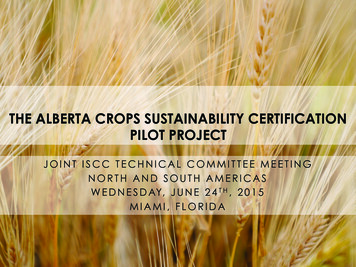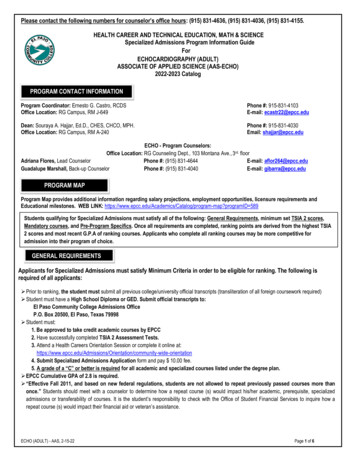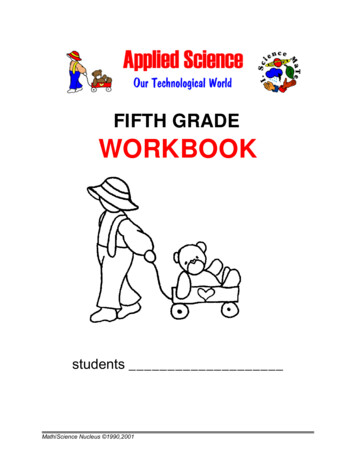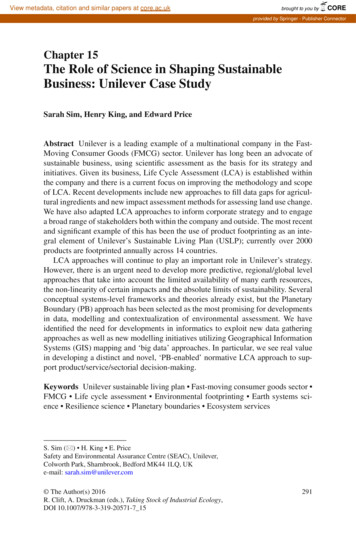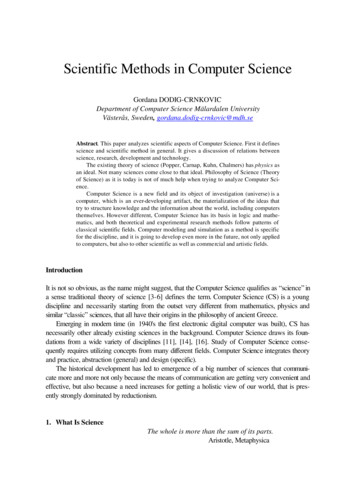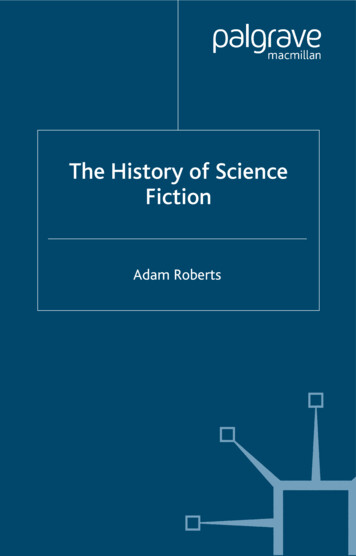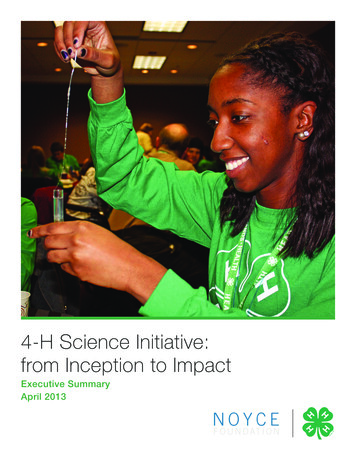
Transcription
4-H Science Initiative:from Inception to ImpactExecutive SummaryApril 2013
IntroductionThe 4-H commitment to improving the science, engineering, technology and math (STEM)skills of America’s youth is stronger now than ever before in the organization’s 110-year history.Thanks to the determination and dedication of the entire organization, 4-H recently achieved amajor goal of engaging more than one million youth in science programs.This milestone was established in response to an alarming report published in 2006,Rising Above the Gathering Storm, that warned: “the danger exists that Americans may notknow enough about science, technology, or mathematics to significantly contribute to, or fullybenefit from, the knowledge-based society that is already taking shape around us.”Building on its successful history of hands-on science education, 4-H responded in asignificant way to help turn around the troubling trend. In 2007, 4-H partnered with theNoyce Foundation to develop a nationally recognized youth development approach toSTEM in out-of-school time (OST). The goal: Engage one million new youth by 2013 in adynamic process of discovery and exploration in OST STEM programs so they are preparedto meet the challenges of the 21st century. The campaign: “One Million New Scientists.One Million New Ideas.” The result: 1.33 million new youth engaged in 4-H Scienceready programs. The multi-year program that helped make this goal possible is detailed ina new report: 4-H Science Initiative: from Inception to Impact. Link to full report:www.4-H.org/youthstemEssential Elements of Success: The Approach: Provide Quality OST STEM Education Through Positive Youth Development.Create life-changing experiences through multi-faceted initiative. The Plan: Build and Sustain a National Infrastructure. Set clear guideposts to achievethe vision and goals of a multi-year initiative. The Process: Implement the Plan. Identify the best people and resources at thenational, state and local levels for achieving the organization’s goals. The Results: Measure and Report Impact. Develop a comprehensive approach toeffectively track and evaluate the progress of the science initiative.April 20134-H Science Initiative: from Inception to Impact2
The APPROACH: Provide Quality OST STEM EducationThrough Positive Youth DevelopmentAt the core of 4-H’s work with young people is a commitment to high-quality positive youth development.This approach requires that young people have access to a long-term relationship with a caring adult,meaningful leadership experiences, and the opportunity to build skills. These factors result in competent,caring, connected, confident, young people of character who contribute to society. The figure below highlightsthe Positive Youth Development (PYD) approach, which is the foundation of the 4-H Science Initiative.4-H PYD INPUTS OUTCOMESSKILLBUILDINGIMPACTCARINGCOMPETENCE4-H POSITIVEYOUTHDEVELOPMENT4-H ULTCHARACTERCONTRIBUTIONCONFIDENCECONNECTEDThe PLAN: Build and Sustain a National InfrastructureEnsuring that the vision, goals and objectives were identified and clearly communicated was the initiative’sfirst priority. It was also essential to develop a national framework to guide successful implementation. Theframework included these components: Program Development and Design Professional Development Curriculum Evaluation and Research Marketing and Communication Funding Partnerships and CollaborationsApril 20134-H Science Initiative: from Inception to Impact3
The PROCESS: Implement the PlanSuccessful implementation required dedicated teams of leaders, experts and educators. 4-H organized aScience Management Team—consisting of local, state and national 4-H leaders —to guide the developmentand implementation of the initiative. To ensure effective communication with state and local 4-H staff andvolunteers, 4-H Science Liaisons from land-grant universities were recruited and trained to assist with thework. National teams of internal and external experts led the work. The full report details the work of each team.Key accomplishments include: The Professional Development (PD) team developed and offered an array of strategies, including web-basedlearning, webinars, conferences, and an E-Academy to prepare state and local 4-H educators and volunteers. The Curriculum team created a rubric and tools, and offered training to enhance current 4-H Sciencecurricula and develop new resources. The Evaluation team developed a plan that: 1) Assessed 4-H staff capacity and capability for designingand implementing 4-H Science programs; 2) Determined the success of 4-H Science for increasing youths’interest, engagement, skills, knowledge and aspirations for STEM education and careers; 3) Identified bestpractices, including frequency, duration and intensity for offering high quality 4-H Science programs; and, 4)Conceived a longitudinal study to compare 4-H Science members with non-4-H youth to assess differencesin STEM interest, engagement, skills, knowledge and aspirations. The Marketing team organized and implemented five 4-H National Youth Science Days (NYSD) to engageyouth in a variety of activities to teach them the fun of STEM. The annual national science experimentsfocused on alternative energy, water conservation and engineering a robot to address environmental issues.In 2012, nearly 9,000 4-H NYSD kits were distributed to support the thousands of young people across thecountry who conducted the experiment simultaneously. The Partnership team worked with over 30 organizations to develop collaborative relationships tosupport 4-H Science. Partners’ involvement ranged from sharing resources, to training, to serving asmentors, coaches and leaders of 4-H Science programs. The Fund Development team developed a variety of resources, including a Fund Development Toolkitwith over 250 online learning modules, templates and resources to enhance fundraising capacity. The teampresented fund development workshops and resources and offered webinars, training and technicalassistance to 4-H staff and volunteers.April 20134-H Science Initiative: from Inception to Impact4
The RESULTS: Measure and Report ImpactSince its inception, 4-H Science Initiative has sought to further the success, sustainability and scalabity of the4-H Science initiative. The focus of this work was to assess evidence of impact and identify promising practices.Evaluation goals for the 4-H Science effort were: Track and monitor the implementation of 4-H Science efforts at the state level Understand the nature of promising and best program practices and how they can be replicated Determine the impact that 4-H Science efforts have on positive youth outcomesIn 2012, ahead of schedule, 4-H achieved its goal of engaging one million new young scientists with 1.33million youth enrolled in 4-H “Science Ready” programs. 4-H’s “Science Ready” standards have helped the4-H system: (1) identify science-focused programs; (2) improve the quality and quantity of programs; and, (3)track youth participation in programs that are aligned with these quality standards.The 4-H Science Checklist became a guide for high-quality “Science Ready” programs. Specifically, “ScienceReady” 4-H experiences: (1) are based on National Science Education Standards; (2) develop participants’science-related skills and abilities; (3) use positive youth development practices; (4) are led by staff who arewell-trained in youth development and appropriate content; (5) use an experiential approach to learning; (6) fostercreativity and curiosity among participants; and, (7) address outcomes on the 4-H Science logic model.In addition, a comprehensive, three-tiered evaluation model assessed the impact and effectiveness of the 4-HScience Initiative.SummativeTier 3:Summative youth outcomesLongitudinal study ofyouth participating in4-H Science programsTier 2:Formative and Summative BestPractices and youth outcomesTier 1:Formative Summative Process and –short-term youth outcomes(short-, medium-, and long-termoutcomes from logic models)Case studies of best andpromising practices sites withpre- and post-surveys(short-, medium-term outcomesfrom logic models)FormativeImplementation Study(Repeated Annually)April 20134-H Science Initiative: from Inception to ImpactYouth Engagement, Attitudes, &Knowledge Survey (YEAK)(Repeated Annually, targeting short-termoutcomes from logic model)5
Tier 1:Process Evaluations: Implementation SurveysThese annual studies provided essential information about the capacity and capability of 4-H professionals andthe 4-H system to deliver 4-H Science programs. They also gathered accountability data on the reach of theprogram, including documenting the number of new youth in 4-H Science programs. Methodologies includedsurveys and interviews with state-level leaders and surveys and interviews with county level leaders.Youth Outcomes: Youth Engagement, Attitudes and Knowledge (YEAK) SurveysThe purpose of the Youth Engagement, Attitudes and Knowledge survey was to determine if 4-H Scienceprograms increased youth engagement, interest, knowledge, skills and attitude toward STEM. The survey wasadministered three different times to samples of 4-H youth. Major findings reported in 2011 include: Youth who participated in 4-H Science programs are significantly more likely than their peers to holdpositive attitudes about science. Participants in high-exposure 4-H Science groups (those spending at least one hour per week for fiveor more months) gave higher ratings to their decision-making, critical thinking and problem solving skillsthan participants from the low-exposure group. 4-H Science participants reported helping in science-related community service projects and teachingothers about science.Further, when compared to the National Assessment of Educational Progress (NAEP) Science examination,youth in 4-H Science programs were more positive about science learning and science careers than otherstudents in the NAEP sample. Comparisons between youth in 4-H Science programs and youth in the NAEPsample from 4th, 8th, and 12th grades yielded similar results.Percentage of youth who agree1008073676040515037514031200When I graduate from highschool, I would like to havea job related to science*I take science onlybecause I have to*I take science onlybecauce it will help me inthe futureTwelfth-Grade 4-H Science Participants (n 42)April 20134-H Science Initiative: from Inception to ImpactScience is one of myfavorite subjects*2009 National Sample (n 11,500)6
Tier 2:Work in this tier sought to gain a deeper understanding of how program practice impacted youth outcomes.An in-depth, multi-method case study was conducted, gathering data from eight highly effective programs.The resulting Priming the Pipeline report recommended the following: Youth Outreach and Recruitment : Design strategies to recruit under-represented youth Staff and Science Volunteers: Recruit scientists to deliver the science content they know and love Professional Development: Provide guidance to science experts on lesson planning, youth deliveryand positive youth development Science Curricula: Manage a realistic yet productive balance between adaptation and fidelity to curriculum Youth Development and Attitudes Towards Science: Enable youth to make meaningful choices about whatthey learn and how they learnTier 3:Finally, the evaluation team worked to lay the foundation for a longitudinal study to assess the long-termimpact of participation in OST STEM and to identify the characteristics that may contribute to positive outcomes.Researchers are currently developing and conducting this study.CONCLUSIONS: Lessons Learned from the 4-H Science InitiativeIn the fall of 2012, at the request of the Noyce Foundation and other partners, 4-H compiled the 4-H ScienceInitiative: From Inception to Impact report. This comprehensive report chronicled the work of the initiative from2006 to 2012, identifying critical lessons learned and best practices required for implementing the plan. Figure3 highlights those lessons.Figure 3: LESSONS LEARNED FROM THE 4-H SCIENCE INITIATIVE: FROM INCEPTION TO IMPACT Communicatevision and goals Articulate clear ,multi-year theoryof changeBegin withthe end in mindThinkComprehensively Establish guidingframework Assessorganizationalreadiness andcapacity Engagewell-respectedpartners Integrate STEMacross programsEstablish strongleadership teamInspirelong-term buy-in Obtain multiyear investmentsand partnerships Evaluate effortsand communicateprogressPromoteand evaluateBeyond the numbers, 4-H Science opened up a world of opportunities for youth. It created youth engagement,increased STEM interest, improved STEM content and provided evidence that this approach does and canproduce positive outcomes for youth.National 4-H Council thanks the Noyce Foundation for its generous support of the 4-H Science Initiative. Itscommitment to positive youth development has made a profound difference in the lives of 1.33 million youngpeople (and growing) whose future is brighter thanks to 4-H Science.April 20134-H Science Initiative: from Inception to Impact7
The campaign:“One Million New Scientists.One Million New Ideas.” The result:1.33 million new youth engagedin 4-H Science-Ready programs.About 4-H4-H is a community of six million young people across America learning leadership, citizenship andlife skills. National 4-H Council is the private sector, non-profit partner of 4-H National Headquarterslocated at the National Institute for Food and Agriculture (NIFA) within USDA. The 4-H programsare implemented by the 111 land-grant universities and the Cooperative Extension System throughtheir 3,100 local Extension offices across the country. Learn more about 4-H at www.4-H.org.About the Noyce FoundationThe Noyce Foundation is interested in significantly increasing the number of youth in the UnitedStates who pursue professions in Science, Technology, Engineering and Mathematics (STEM).It believes that providing large numbers of young people with out-of-school, engaging, quality,hands-on science, engineering, and technology experiences will enhance general STEMknowledge and stimulate a larger percentage to pursue STEM careers. The Foundation’s goal isto support the informal science community in developmental initiatives that address gaps inoutcome measurement, research and evaluation, program scale-up, leadership developmentand policy issues. www.noycefdn.org
Feb 04, 2016 · Rising Above the Gathering Storm, that warned: “the danger exists that Americans may not know enough about science, technology, or mathematics to significantly contribute to, or



